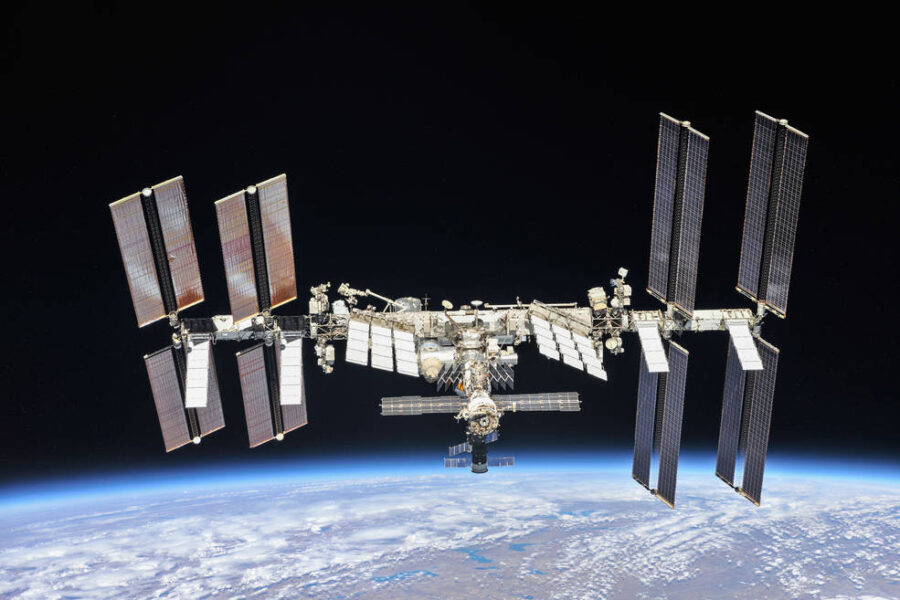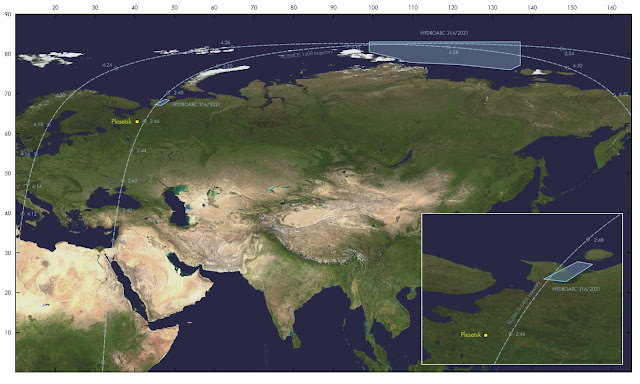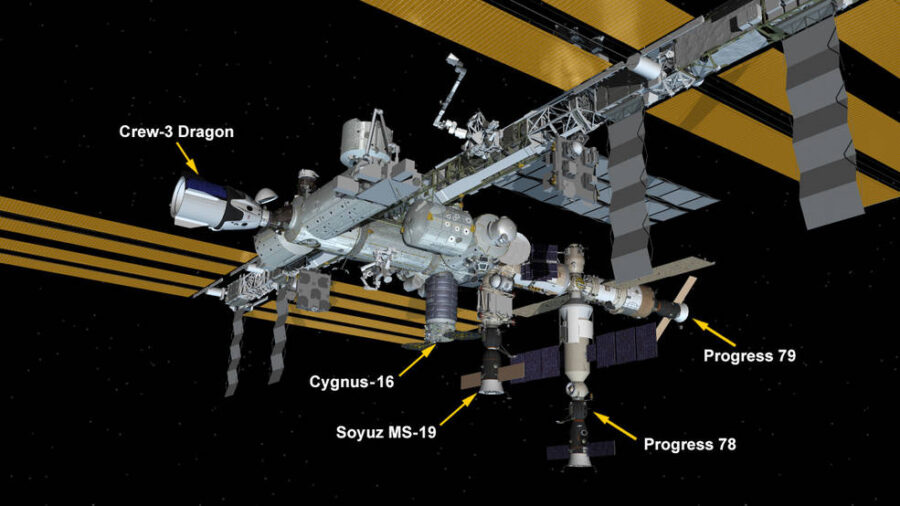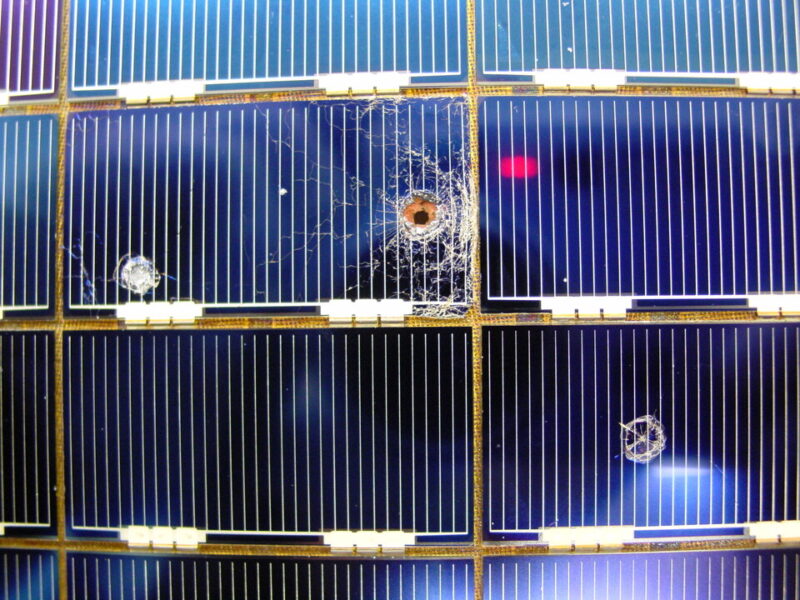A Russian missile struck a defunct satellite early Monday morning, forcing International Space Station crew to shelter in place.

NASA
Notice first came, like so many things these days, as a rumor across Twitter.
Word spread early Monday morning that Russia had carried out a direct ascent anti-satellite (ASAT) missile test against one of its own aging satellites, and that the resulting debris had prompted the crew aboard the International Space Station (ISS) to take protective measures.
The U.S. State Department and U.S. Space Command confirmed the test later on Monday, and NASA also issued a statement condemning the test. NASA continues to monitor the evolving situation.
“Earlier today, due to debris generated by the destructive Russian Anti-Satellite (ASAT) test, ISS astronauts and cosmonauts undertook emergency procedures for safety,” said Bill Nelson (NASA-Administrator) in a press release on Monday. “Like Secretary Blinken, I’m outraged by this irresponsible and destabilizing action. All nations have a responsibility to prevent the purposeful creation of space debris from ASATs and to foster a safe, sustainable space environment.”
Russia confirmed the test, and the Russian space agency Roscosmos issued a brief statement saying, “For us, the main priority has been and remains to ensure the unconditional safety of the crew.” The agency continues “to monitor the situation in order to prevent and counter all possible threats to the safety of the International Space Station and its crew.”
Satellite tracker Marco Langbroek notes that an earlier set of Navigational Warnings (notices sent out via the Maritime Safety Office), along with the approximate position of Kosmos-1408 at the time, would suggest that the missile launch occurred out of the Plesetsk Cosmodrome around 2:52 UT early Monday.

Marco Langbroek
Threats to Space Stations
There are currently 10 humans in space, all in low-Earth orbit: seven aboard the ISS (four from NASA, two from Roscosmos, and one from the European Space Agency) and three aboard China’s Tiangong space station.
At 2:00 a.m. EST (7:00 UT) on Monday, NASA directed crew on the ISS to seal off the Columbus, Kibo, Joint Quest Airlock, Bigelow Expandable Activity, and the Permanent Multipurpose modules. The crew sat out close debris passes in the Soyuz MS-19 spacecraft and the newly arrived Crew Dragon 3 Endurance vehicle, in case station departure became necessary.
The event is not without precedent, as ISS crew have ridden out close debris passes in their Soyuz “lifeboats” before.

NASA
The station now approaches the debris field once every 90 minutes. However, specialists at NASA’s Johnson Spaceflight Center Orbital Debris Program Office only deemed it necessary for the crew to shelter in place on the second and third passes.
Some new debris objects from today's breakup (orange orbit) visualized relative to ISS (blue orbit). Objects in white denote largest pieces of Cosmos 1408 tracked by LeoLabs. (Dots not to scale.) Debris ranges in altitude from 440 to 520km. pic.twitter.com/4ElV9KrK4P
— LeoLabs, Inc. (@LeoLabs_Space) November 16, 2021
There’s no word as of yet if crew aboard Tiangong took similar measures. It also remains unclear if there’s any immediate impact on other satellites, including SpaceX’s thousands of Starlink communication satellites.
The target of the missile launch was Kosmos-1408 (COSPAR ID 1982-092A/13552) a defunct, Soviet-era Tselina-D SIGNIT (Electronic Signals Intelligence) satellite in low-Earth orbit. The satellite is in a 94-minute, 465-by-490 kilometer orbit, inclined 82.6 degrees relative to the equator.
A statement on the U.S. Combined Space Operations Center (CSpOC) Space-Track’s front page reads:
“The 18th Space Control Squadron has confirmed the breakup of COSMOS-1408 (INTLDES 1982-092A, SCC 13552). Data indicates the breakup occurred on November 15, 2021. As of 1720 UT, November 15, 2021, 18 SPCS estimates that there are at least 1,500 associated pieces, all of which are being incorporated into routine conjunction assessment to support spaceflight safety. At this time, there is no additional data available on this event if you log into the website.”
This comes at a time not only of heightened tensions between Russia and Ukraine on Earth, but an increasing burden of debris in low-Earth orbit (LEO).
Multiple nations have performed anti-satellite tests. China carried out a test in 2007, adding an estimated 2,000 pieces of debris larger than a golf ball to LEO. The U.S. also undertook Operation Burnt Frost in 2008 to take out the failed spy satellite USA-193 with a missile fired from the U.S.S. Lake Erie. (Back in the 1980s, the U.S. also carried out an air launch of antisatellite missile ASM-135, fired from an F-15C Eagle fighter jet.) And in 2019, India carried out an ASAT against its MicroSat-R satellite.
The collision between Kosmos-2251 and Iridium-33 in 2009 also added to the burden of space junk in LEO and highlighted the growing problem of space debris. Many pundits fear that there could be a tipping point known as the “Kessler Syndrome” or ablation cascade, in which one impact leads to another and another.

ESA
The current Outer Space Treaty bans the use of nuclear weapons in space but not conventional ASATs. Many proponents have called for a formal international ban on anti-satellite missile tests all together. Certainly, this week’s test by Russia has heated up the militarization of space and has exacerbated an already tense situation.
 0
0









Comments
You must be logged in to post a comment.